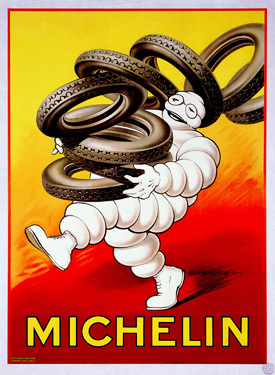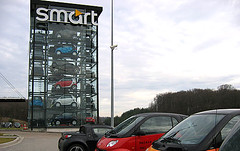"Rallying together towards sustainable mobility"
 In 1898 the Michelin Tire Corporation introduced Bibendum (Bibo), its company icon. At that time the firm was a leader in the production of pneumatic bicycle tires. By 1900 Michelin achieved dominance in the French market for automobile tires, and on the eve of World War I Michelin supplied approximately a third of the world's tires. While bicycles were becoming mass-market goods, automobiles remained elite commodities. Michelin thus had a vested interest in encouraging automobile travel as a way to sell tires, and in educating new consumers as to its uses and capabilities. Bibendum, helped to do both. Appearing in posters and the press as a well to do Frenchman who embodied contemporary assumptions about class and racial privileges and appropriate activities (such as automobile travel and tourism), Bibendum also dispersed advice on technical matters pertaining to autos and tires.
In 1898 the Michelin Tire Corporation introduced Bibendum (Bibo), its company icon. At that time the firm was a leader in the production of pneumatic bicycle tires. By 1900 Michelin achieved dominance in the French market for automobile tires, and on the eve of World War I Michelin supplied approximately a third of the world's tires. While bicycles were becoming mass-market goods, automobiles remained elite commodities. Michelin thus had a vested interest in encouraging automobile travel as a way to sell tires, and in educating new consumers as to its uses and capabilities. Bibendum, helped to do both. Appearing in posters and the press as a well to do Frenchman who embodied contemporary assumptions about class and racial privileges and appropriate activities (such as automobile travel and tourism), Bibendum also dispersed advice on technical matters pertaining to autos and tires.is the slogan for Challenge Bibendum, sponsored by Michelin. This three-day conference focuses on "what if" and was written about by Washington Post automobile columnist Warren Brown, in the piece, "Energy Policy Without the Fear Factor." From the article:
Bibendum, named after Michelin's century-old, rubberized, rotund mascot, is not intended to give concrete answers to the many troublesome questions about the kinds of vehicles we drive and their overall effect on natural resource depletion and society. Bibendum's mission is to confront fear, to ask: "What if?''
For example, what if we developed policies that required normal commuters--those not hauling construction equipment or commercial property--to use smaller vehicles in downtown traffic during weekday business hours? What if we assessed parking fees based on vehicle size, charging higher fees for bigger vehicles and lower rates for smaller cars and trucks? Would that make more sense than the current rush to reward the buyers of expensive gasoline-electric hybrid models with tax breaks--even though many of those hybrids get the equivalent mileage, or sometimes less than that of small economy cars?
Why do we need so many vehicles with seven seats? Look around you. How many minivans, SUVs, station wagons and large sedans are carrying more people than the driver?
 Why Mini or the Smart Car doesn't create center city small car dealerships is beyond me. (Photo from DaimlerChrysler.) Although the Smart Car is a really small car, and the Mini is much larger comparatively.
Why Mini or the Smart Car doesn't create center city small car dealerships is beyond me. (Photo from DaimlerChrysler.) Although the Smart Car is a really small car, and the Mini is much larger comparatively.What if someone developed a one-passenger car, or if a car company was brave enough to give more than a passing glance to Italian architect Romolo Nati's idea for the B.U.S. (Block Utility Service) car--a three-wheeled, three-seat bubble of a thing designed for inner-city transportation?
Answers to those questions have attendant problematical queries related to safety, property rights, consumer choice and lifestyle. But, again, the idea behind Challenge Bibendum is not to force solutions down consumers' throats.
_______
Interestingly enough, I have suggested some of these kinds of ideas in various blog postings. Too bad I wasn't invited to go to Shanghai...
Index Keywords: mobility



0 Comments:
Post a Comment
<< Home